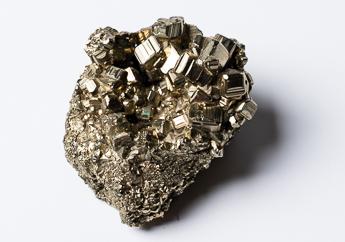Missouri Geological Survey Director: Carey Bridges, RG
Pyrite (iron disulfide, FeS2) is typically a secondary mineral in small quantities of other rocks and ore deposits. The diagnostic physical properties of pyrite are brassy metallic luster, black streak, brittle fracture, hardness greater than that of glass, absence of cleavage and it is nonmagnetic. The crystalline structure of pyrite can produce crystals in the shape of cubes, octahedrons or pyritohedrons, and commonly have striations on the crystal faces. It may be found in many areas of the state.

Pyrite is the most widespread and abundant of the sulfide minerals and it occurs in all types of rock. Often found in coal, limestone and dolomite, pyrite is a common mineral that occurs in quartz veins with many other economically important metallic sulfide minerals, such as galena, sphalerite and chalcopyrite, and in quartz veins with elements like gold and silver.
When at or near the surface, pyrite weathers relatively rapidly as it reacts chemically with water and atmospheric oxygen. This weathering can produce a type of rust that often stains rock outcrops with a reddish hue. The swamps of Missouri’s past that covered much of western and central Missouri during what geologists call the Pennsylvanian Period of geologic time (365-290 million ears ago) produced one form of pyrite. As the plants and animals of these swamps died, they fell to the bottom of the swamp. The layers of carbon accumulated until sea levels eventually rose and covered them with sediment. Burial under those sediments produced both pressure and heat that forced the organic matter of the swamp to undergo physical and chemical changes and become coal. Under the oxygen-poor conditions of the swamp, sulfur combined with iron to form pyrite – an impurity in the coal.
When pyrite-rich rocks are brought to the surface by mining, they react to the oxygen in the air. This oxidization in combination with iron-loving bacteria converts the pyritic sulfur into sulfuric acid. The reddish or yellow color of mine runoff is iron and other minerals dissolved in the acidic water.
Pyrite can be used as a source of sulfur in the manufacture of sulfuric acids for both industry and agriculture. It can be burned to produce sulfur dioxide for use as a food preservative, but it is considered a toxic gas when emitted from the smoke stacks of a coal-fired power plant. Pyrite has been used in jewelry making for several centuries and it remains popular today. However, it is often misnamed and sold as marcasite.
Pyrite is on display in our Ed Clark Museum of Missouri Geology.
Nothing in this document may be used to implement any enforcement action or levy any penalty unless promulgated by rule under chapter 536 or authorized by statute.
For more information
Geological Survey Program
Missouri Geological Survey
P.O. Box 250
Rolla, MO 65402-0250
United States
